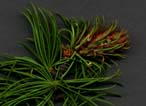
Bole and, in right background, pale green foliage of mature trees in a mixed-conifer forest [Emily Heyerdahl].

Twig with young needles and immature female cone [C.J. Earle].

Western larch (4).
Common Names
Western larch, western tamarack, hackmatack (5), mountain larch (6), mélèze occidental (7).Taxonomic notes
Described in 1806 by Lewis and Clark but not recognized as a distinct species until 1849, when described by Thomas Nuttall (6). Several studies have examined hybridization with Larix lyallii (9, 10, 11).Description
Trees to 50 m tall; long clear trunk to 200 cm dbh; crown short, conic. Bark thin and scaly when young, becoming thick (to 15cm), plated, deeply furrowed, reddish brown when older. Branches horizontal, occasionally drooping in lower crown of open-grown trees; twigs orange-brown, initially pubescent, becoming glabrous or very sparsely pubescent during first year. Buds dark brown, generally puberulent, scale margins erose. Needles of short shoots 2-5 cm × 0.65-0.80 mm, 0.4-0.6 mm thick, keeled abaxially, with shallow convex midrib adaxially, soft, pale green, turning bright yellow in autumn, in circular clusters of 15-30 on spur twigs and singly along current year's growth; resin canals 20-50 µm from margins, each surrounded by 5-7 epithelial cells. Seed cones oval when closed, ovoid when open, 2-3 × 1.3-1.6 cm, on curved stalks 2.5-4.5 × 3.5-5 mm; scales 45-55, margins entire, adaxial surface pubescent; bracts tipped by awn to 3 mm, exceeding scales by ca. 4 mm. Pollen 71-84 µm diam. Seeds reddish brown, body 3 mm, wing 6mm. 2 n =24 (6, 7).Range
Canada: British Columbia; USA: Montana, Idaho, Washington and Oregon at 500-2135 m, usually in mountain valleys and lower slopes (1, 7). See also (15).Big Tree
Height 57.6 m, dbh 186 cm, crown spread 11 m, in Wenatchee National Forest, WA; also height 49.4 m, dbh 221 cm, at Seeley Lake in Lolo National Forest, MT (8, 12).Oldest
The oldest crossdated sample, presumably based on living-tree material, spans 493 years (3). An age of 920 years is reported for a ring count from a stump in a clearcut near Cranbrook, BC (14).Dendrochronology
Ethnobotany
It produces a sweet gum that hardens when exposed. Native peoples would chew this gum for its sugar (galactan, which tastes like a slightly bitter honey), thought to have medicinal qualities. Today, trees are sometimes tapped for a sap that can be dried to a syrup and then mixed with sweeteners. It is currently one of the most valuable timber-producing species in western North America, where its close-grained, durable wood is used in framing, railway ties, pilings, exterior and interior finishing work, pulp and as firewood. The bark contains Arabino galactan, a water-soluble gum used for offset lithography and in pharmaceuticals, paint and inks (6, 7).Observations
A fairly common tree in montane forest of the eastern Cascades (WA) and the Blue Mountains (WA/OR).Remarks
Western larch is widespread in mixed upland stands. It prefers north exposures although it is very shade-intolerant. The thick bark and early self-pruning of mature trees make it fire tolerant, permitting it to live for centuries and attain very large sizes; it is the largest of all larches. Larch seeds germinate and grow readily on recently burned soils. Fire production and selective logging, along with its shade intolerance, have reduced the abundance of this larch in many managed forests. The larch casebearer, Coleophora laricella , is an introduced European insect pest that feeds on young foliage and has further contributed to the decline of this species (6).Citations
(1) Silba 1986 .(2) "Larch," Encarta 97.
(3) International Tree-Ring Data Bank, chronology WA052, limiting dates 1487-1980.
(4) Elias 1987 .
(5) Peattie 1950 .
(6) Parish et al. 1996 .
(7) William H. Parker at the Flora of North America web site .
(8) American Forests 1996 .
(9) Carlson 1965 .
(10) Carlson et al. 1991 .
(11) Knudsen 1968 .
(12) E-mail communication from Robert Van Pelt, who measured some of these
trees; 18-Mar-1998.
(13)
Burns & Honkala 1990
, p.165.
(14) R. Stoltmann. 1993. Guide to record trees of British Columbia. Vancouver: Western Canada Wilderness Committee. 58pp.
(15) Robert S. Thompson, Katherine H. Anderson and Patrick J. Bartlein. 1999. Atlas of Relations Between Climatic Parameters and Distributions of Important Trees and Shrubs in North America. U.S. Geological Survey Professional Paper 1650 A&B. URL= http://greenwood.cr.usgs.gov/pub/ppapers/p1650-a/pages/conifers.html , accessed 22-Jan-2000.
See also:
Arno, Stephen F. and J.R. Habeck. 1972. Ecology of alpine larch (
Larix lyallii
Parl.) in the Pacific Northwest.
Ecological Monographs
42(4): 417-450.
FEIS database
.
Owens and Simpson 1986
.
back | Larix | Pinaceae | home
This page is from the Gymnosperm Database
URL: http://www.geocities.com/~earlecj/pi/la/occidentalis.htm
Edited by Christopher J. Earle
E-mail:
earlecj@earthlink.com
Last modified on 24-Jan-2000